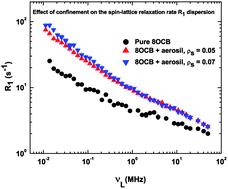Effect of confinement on molecular processes in the liquid crystal 8OCB: application of NMRrelaxometry
Abstract
Dispersions of

* Corresponding authors
a
School of Physics, University of Hyderabad, Hyderabad 500 046, India
E-mail:
raji.hcu@gmail.com
Fax: +91-40-23010227
Tel: +91-40-23134318
b Soctronics Technologies Pvt. Ltd, Banjara Hills, Hyderabad 500 034, India
c Institute of Chemistry, Military University of Technology, Warsaw 00-908, Poland
Dispersions of

 Please wait while we load your content...
Something went wrong. Try again?
Please wait while we load your content...
Something went wrong. Try again?
M. Rajeswari, S. Dhara, K. Venu, V. S. S. Sastry and R. Dabrowski, Soft Matter, 2012, 8, 10008 DOI: 10.1039/C2SM25643F
To request permission to reproduce material from this article, please go to the Copyright Clearance Center request page.
If you are an author contributing to an RSC publication, you do not need to request permission provided correct acknowledgement is given.
If you are the author of this article, you do not need to request permission to reproduce figures and diagrams provided correct acknowledgement is given. If you want to reproduce the whole article in a third-party publication (excluding your thesis/dissertation for which permission is not required) please go to the Copyright Clearance Center request page.
Read more about how to correctly acknowledge RSC content.
 Fetching data from CrossRef.
Fetching data from CrossRef.
This may take some time to load.
Loading related content
